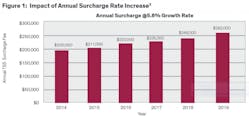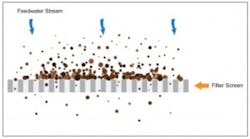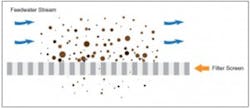Water scarcity and tightening regulations on water use are not only increasing the cost of fresh water globally, but are also raising the price of municipal and industrial wastewater treatment. In fact, a recent Global Water Intelligence Water Tariff Survey indicates an average annual increase of eight percent in water utility rates from 2011 to 2014 across 46 major cities.
Additional threats to profitability include the growing cost of pretreating water in-house to comply with lower effluent limits prior to discharge and to reduce escalating municipal surcharges imposed on companies that exceed limits for total suspended solids (TSS) or biological oxygen demand (BOD). TSS surcharges alone increased an average of 5.9 percent per year nationwide, based on a 10-year average reported in NACW.org Wastewater Surcharge Index 2013, or two times the consumer price index (Index 1).
Based on historical wastewater utility data and 250,000 gpd of wastewater at $0.15/lbs. excess TSS for year one. Source for rate increase of 5.9 percent: NACWA.org Wastewater Surcharge Index 2013.
Industrial water users can reduce water utility costs by filtering wastewater prior to discharge or by filtering to enable reuse, allowing them to stay in compliance with effluent limits while sustaining their bottom lines.
A variety of treatment technologies can be used to remove suspended solids, sand and other impurities from wastewater streams. These include coarse screening, clarification methods such as dissolved air flotation (DAF), conventional dead-end filtration such as cartridges and bag filters, and self-cleaning particle filtration ranging from the traditional to the advanced.
Dissolved air flotation (DAF)
DAF units are common in food and beverage wastewater treatment systems because they effectively remove a significant percentage of solids with specific gravities close to or less than one. Their ability to capture and skim fats, oils and grease (FOG) is a particular advantage. However, DAF may be an expensive proposition and complex to operate. Capital investment alone can exceed $1 million, and many DAF units require costly chemicals to operate, take up significant floor space and require highly trained and knowledgeable operators to balance the added chemicals with variations in the characteristics of the incoming wastewater.
Figure 2. Dead-end filtration with buildup and caking
Dead-end filtration
Dead-end filtration products, on the other hand, are often challenged by high solids loadings and FOG, which quickly clog the screens. The fluid in the water stream passes through the filter screen, and all particles larger than the pore size of the filter screen are held at the surface of the screen. However, as the trapped particles build up, a cake layer starts to form on the surface of the filter screen until the filter cake makes water passage too difficult. Once this occurs, the filter must be taken offline to remove the filter case with a backwash cycle, or until the filter media is replaced; this results in higher maintenance, downtime and consumables costs, not to mention more waste disposal (from discarded filters) (Figure 2).
Traditional cross-flow filters
Cross-flow filters seek to avoid maintenance and consumable issues by providing a continuous cleaning action. With traditional cross-flow filtration, the fluid in the water stream runs parallel to the filter screen. Controlling the velocity of the feedwater flow over the surface of the screen manages the buildup of particles. A small cake layer, however, can still reduce flow and increase pressure across the screen.
Advanced self-cleaning filters
Figure 3. Advanced self-cleaning filters with cross-flow filtration avoid cake buildup
An advanced self-cleaning filtration system is available that combines the power of continuously cleaning, cross-flow filtration with forced setting and solids collection, maintaining a good pressure differential across the screen and creating a condition where particles prefer to flow past the screen rather than through it — resulting in even cleaner filtrate (Figure 3). It is designed to operate in high solids (in excess of 100 – 10,000+ mg/l) and high FOG water, filtering down to 10 microns, without the need for backwashing, chemical cleaning or frequent filter changes.
Opportunities to reduce water costs
Food and beverage companies not only require water as a product ingredient, but also utilize the resource to run manufacturing processes, convey products and clean equipment. This, in turn, generates significant volumes of high-solids wastewater. Some companies can afford to meet regulations for discharge with in-house wastewater treatment plants, but continue to look for ways to reduce costs and improve efficiency. Other companies, however, cannot afford to pretreat water and are thus vulnerable to escalating water utility rates and surcharges.
Because advanced self-cleaning filters can reduce TSS in a more operationally efficient manner, they offer a solution to both situations. First, companies previously unable to afford water treatment now have the opportunity to add a simple, affordable and reliable wastewater treatment step to their operations. Second, companies with existing wastewater treatment systems now have the chance to optimize their existing process, adding reliability, reducing chemical loads and mitigating related environmental concerns.
Advanced self-cleaning filters can deliver value at several points in the process, including prior to discharging dirty water to the municipal wastewater treatment plant in order to reduce surcharges; prior to DAF to reduce solids loading and chemical requirements; post-DAF to reuse water for spraying drum screens; or as pretreatment to protect and extend the life of dead-end filters or membrane systems, such as ultrafiltration (UF) and reverse osmosis (RO). In some cases, physical separation of solids with advanced self-cleaning filters could even eliminate the need for DAF.
Advanced self-cleaning filters are used to filter out difficult solids in many environments. Left: filtering untreated slaughterhouse water containing fibrous paunch material. Right: Filtering poultry plant wastewater entering DAF.
Beaker to the left is prior to treatment; beaker on the right is after treatment — note how the self-cleaning filter effectively removed the settled solids. Photos courtesy of Dow Water & Process Solutions.
The realities of reuse
Many companies think reusing wastewater is too complicated or risky to attempt due to public health concerns. The truth, however, is that the complexity and risk depend on the application; and in some cases, wastewater can be filtered relatively inexpensively for low-risk uses. One example is cleaning wastewater treatment equipment like drum screens that would otherwise require a lot of fresh water.
A beef processing plant in Texas recently piloted an advanced self-cleaning filter in an attempt to reuse DAF effluent for drum screen cleaning, which would save approximately 150,000 gallons per day of fresh water. The filter was able to continuously operate in the high FOG DAF effluent with TSS in the hundreds, successfully removing particles greater than 30 microns. Removing these particles enables water reuse, protecting the cleaning spray bars from clogging. Potential water bill savings are estimated at $250,000 annually. Considering the eight percent increase in average water utility rates mentioned earlier, the savings could grow to $370,000 in five years.
Driving down costs across the board
Municipalities assign an "excess TSS" surcharge rate to companies exceeding TSS, based on pounds of TSS above the threshold. Food and beverage companies often produce high-solids wastewater containing a variety of food matter — the higher the excess TSS, the higher the surcharge.
Advanced self-cleaning filters are proving their value in both installations and pilots in a number of food and beverage applications — from reducing surcharges and chemical costs to cutting consumables expenses.
- Reducing surcharges: A large brewery in California recently tested advanced self-cleaning filtration technology to save more than $500,000 per year in TSS surcharges by removing the majority of solids in digester effluent prior to it leaving the plant. A successful pilot demonstrated the ability for an advanced self-cleaning filter to reduce TSS by 60 to 80 percent from 800 mg/l, saving the brewer $300 in surcharges per pound of solids removed. Capturing solids may also bring added value as animal feed or feedstocks to produce energy.
- Decreasing chemical costs: A pork processing plant in Oklahoma demonstrated that it can save $180,000 per year in chemical costs by filtering solids prior to DAF. Physically separating out 50 percent of the solids entering DAF from an initial level of 1,750 mg/l lowers the requirement for coagulants and polymers. Overall, a 60 percent reduction in chemical costs could be realized. This plant hopes to completely replace DAF in the future with a self-cleaning filter.
- Cutting consumables expenses: A pork processing plant in Kansas notably reduced costs and improved the capacity of its wastewater system with advanced self-cleaning filtration technology. The plant installed the filter downstream of DAF to protect bag filters and a UF filter. Without the self-cleaning filter, high FOG and TSS drove the plant to change out bag filters every five minutes during the nighttime wash-down period. The UF filter was losing 80 percent of its capacity due to fouling, requiring chemicals to recover the capacity. With the filter, UF capacity was maintained with fewer chemicals and bag filter change outs were 80 percent less frequent.
Advanced self-cleaning filters at a pork processing plant in Kansas. Photo courtesy of Dow Water & Process Solutions.
Implications of success
According to the United Nations, 30 percent more water is estimated to be needed by 2030 to accommodate a growing and increasingly affluent world. Rising water costs and tougher regulations are driving a variety of conservation efforts as everyone seeks to get the most out of every drop. The more the food and beverage industry can improve efficiencies in wastewater treatment, the better it can focus its attention on delivering food to the world.
The success stories shared in this article demonstrate the potential for advanced self-cleaning filters to solve important challenges across industrial wastewater treatment applications. Filters capable of operating continuously in high TSS waters with challenging constituents like FOG and fibers offer a relatively simple and perhaps more affordable, long-term solution for TSS reduction than what is generally found with current filtration and clarification technologies. Faced with the challenge of reducing very high and variable TSS levels, food and beverage companies are prime candidates to benefit from advanced self-cleaning filters.
Considering the limited availability and rising cost of fresh water, as well as increasingly stringent municipal and environmental regulations, finding a more efficient alternative to treat and reuse wastewater will remain at the top of the agenda.
Ben Orton is the marketing manager for filtration at Dow Water & Process Solutions. In this role, he is responsible for creating strategic marketing and product strategies for ultrafiltration products and the TEQUATIC™ PLUS Filter within North America, developing new markets and driving next-generation technologies in collaboration with key customers. He can be reached by email at [email protected] or by phone at 952-897-4313.







